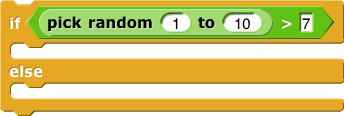On this page, you will create a new block that will make the program feel more like a conversation by using phrases like "I heard," "Who cares!" or "Well, guess what" instead of always "Oh, but."
block that will make the program feel more like a conversation by using phrases like "I heard," "Who cares!" or "Well, guess what" instead of always "Oh, but."

On this page, you will create a new block that will make the program feel more like a conversation by using phrases like "I heard," "Who cares!" or "Well, guess what" instead of always "Oh, but."
block that will make the program feel more like a conversation by using phrases like "I heard," "Who cares!" or "Well, guess what" instead of always "Oh, but."

 block. Instructions are below.
block. Instructions are below. in the Variables palette, or Control-click (or right-click) in an empty spot in the scripting area and choose "make a block..."
in the Variables palette, or Control-click (or right-click) in an empty spot in the scripting area and choose "make a block..." 
 .
.join).In Snap!, every block needs a color category, also known as a palette. Gray ("Other") is the default. It also needs a type (shown by the block's shape), a title, and a script that defines its behavior.

 and
and  .
.who, does what, and who2.
item to change "1" to random.list with phrases.In many programming languages, what Snap! calls a reporter (blocks with an oval shape like  ) is called a function and what Snap! calls a command (blocks with a puzzle shape like
) is called a function and what Snap! calls a command (blocks with a puzzle shape like  ) is called a procedure. But programming languages are not consistent about this. Some use "function" for both, and others use "procedure" for both. (Also, most languages use these words only for procedures or functions that you write, not the ones that are built into the language.)
) is called a procedure. But programming languages are not consistent about this. Some use "function" for both, and others use "procedure" for both. (Also, most languages use these words only for procedures or functions that you write, not the ones that are built into the language.)
The AP Exam uses the word procedure for both reporters and commands.
gossip response block by clicking it several times. It should behave like the who, does what, and who2 blocks.gossip2, and insert gossip response in place of the text "Oh, but...."

gossip2 also.gossip and gossip2 so that sometimes, not too often, they say something like "John and Paul" using two of the names in the lists of who or who2.

does what with different lists, or you can try to take a verb reported by does what and use a set of rules ("if the word ends in x change it to zz") to turn it into a plural verb.